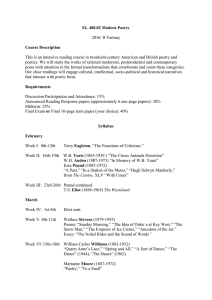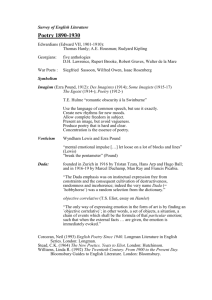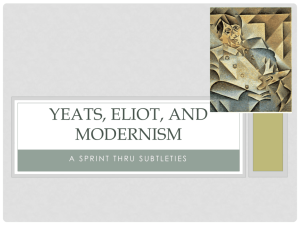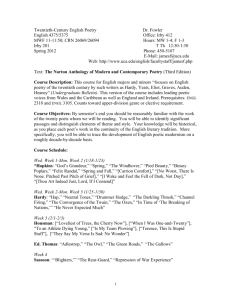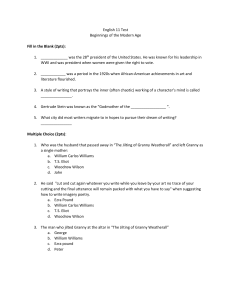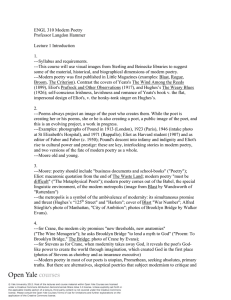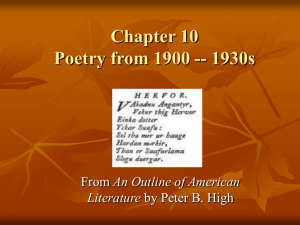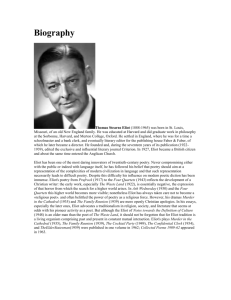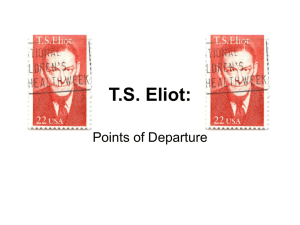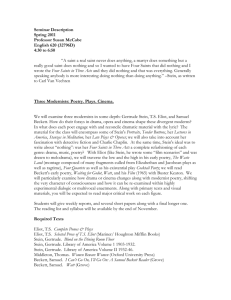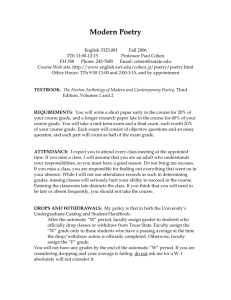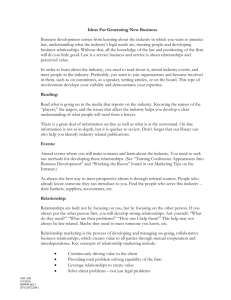Pázmány Péter Katolikus Egyetem
advertisement
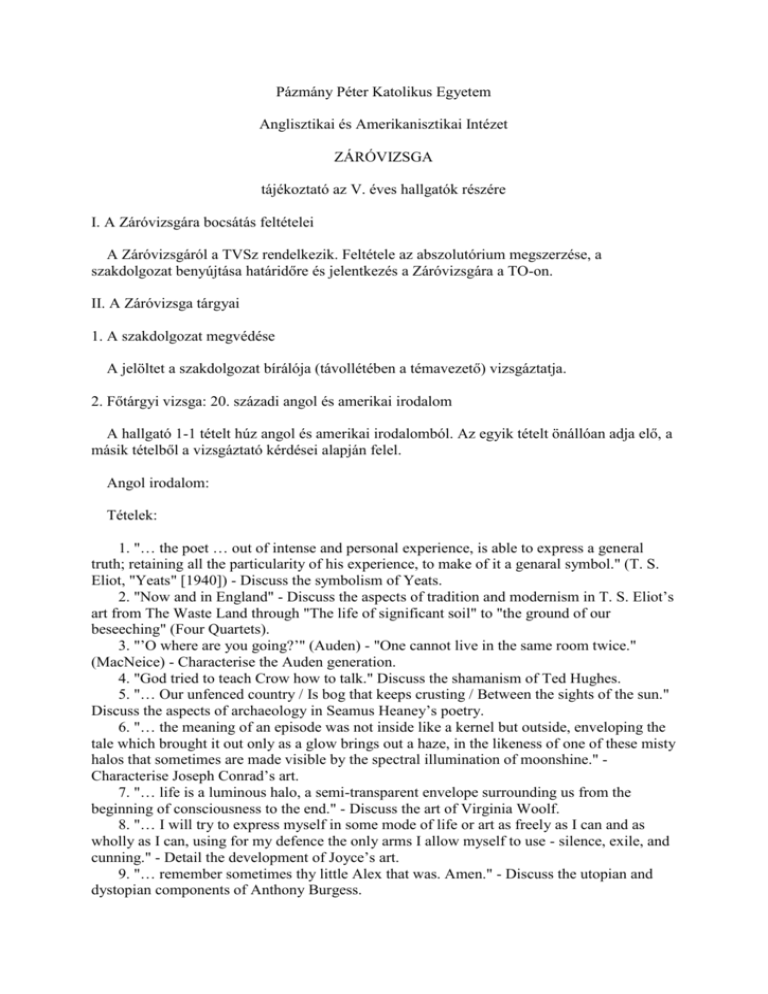
Pázmány Péter Katolikus Egyetem Anglisztikai és Amerikanisztikai Intézet ZÁRÓVIZSGA tájékoztató az V. éves hallgatók részére I. A Záróvizsgára bocsátás feltételei A Záróvizsgáról a TVSz rendelkezik. Feltétele az abszolutórium megszerzése, a szakdolgozat benyújtása határidőre és jelentkezés a Záróvizsgára a TO-on. II. A Záróvizsga tárgyai 1. A szakdolgozat megvédése A jelöltet a szakdolgozat bírálója (távollétében a témavezető) vizsgáztatja. 2. Főtárgyi vizsga: 20. századi angol és amerikai irodalom A hallgató 1-1 tételt húz angol és amerikai irodalomból. Az egyik tételt önállóan adja elő, a másik tételből a vizsgáztató kérdései alapján felel. Angol irodalom: Tételek: 1. "… the poet … out of intense and personal experience, is able to express a general truth; retaining all the particularity of his experience, to make of it a genaral symbol." (T. S. Eliot, "Yeats" [1940]) - Discuss the symbolism of Yeats. 2. "Now and in England" - Discuss the aspects of tradition and modernism in T. S. Eliot’s art from The Waste Land through "The life of significant soil" to "the ground of our beseeching" (Four Quartets). 3. "’O where are you going?’" (Auden) - "One cannot live in the same room twice." (MacNeice) - Characterise the Auden generation. 4. "God tried to teach Crow how to talk." Discuss the shamanism of Ted Hughes. 5. "… Our unfenced country / Is bog that keeps crusting / Between the sights of the sun." Discuss the aspects of archaeology in Seamus Heaney’s poetry. 6. "… the meaning of an episode was not inside like a kernel but outside, enveloping the tale which brought it out only as a glow brings out a haze, in the likeness of one of these misty halos that sometimes are made visible by the spectral illumination of moonshine." Characterise Joseph Conrad’s art. 7. "… life is a luminous halo, a semi-transparent envelope surrounding us from the beginning of consciousness to the end." - Discuss the art of Virginia Woolf. 8. "… I will try to express myself in some mode of life or art as freely as I can and as wholly as I can, using for my defence the only arms I allow myself to use - silence, exile, and cunning." - Detail the development of Joyce’s art. 9. "… remember sometimes thy little Alex that was. Amen." - Discuss the utopian and dystopian components of Anthony Burgess. 10. Discuss the postmodern and multicultural aspects of Kazuo Ishiguro’s art. 11. The Renewal of English Drama (Wilde, Shaw, Eliot) 12. The Irish Renaissance (Yeats, Synge, O’Casey) 13. The Theatre of the Absurd (Beckett, Pinter) 14. The Angry Young Men (Osborne, Wesker) 15. The Latest Development in British Drama (Stoppard, Shaffer, Friel) Áttekintés: In: * The Penguin History of Literature: The Twentieth Century * The New Pelican Guide to English Literature, Vols 7 and 8. Amerikai irodalom Tételek: 1. Internationalism – Localism Discuss the view of America from Europe through the works of Henry James, Gertrude Stein, and Ernest Hemingway. Discuss the term “localism” in contrast with “expatriation” and trace it in the works of William Carlos Williams, Robert Frost, Sinclair Lewis, Theodore Dreiser, Kate Chopin, or Carl Sandburg. Or: Explore and compare the narrative techniques in three of the following works: Henry James’s The Turn of the Screw, William Faulkner’s A Rose for Emily, The Sound and the Fury, F. Scott Fitzgerald’s The Great Gatsby. 2. Define the term minimalism. In what sense are Gertrude Stein, Ernest Hemingway, and Jack Kerouac forerunners of minimalism? Or: Explore manifestations of realism and naturalism in the works of Sinclair Lewis and Theodore Dreiser. 3. Describe the meaning of “loss” in what Gertrude Stein labeled as “The Lost Generation.” Characterize the features of this “generation” with reference to representative works. Or: Trace manifestations of absurd realism in Joseph Heller’s Catch 22 or Kurt Vonnegut’s Slaughterhouse 5. 4. Discuss the fall of the “Old South” in William Faulkner’s A Rose for Emily and Tennessee Williams’s A Streetcar Named Desire. Or: Define the term “social realism” and trace how John Steinbeck and Arthur Miller comment on the American Dream in any of their representative works. 5. What are the different manifestations of modernism in the poetry of T.S. Eliot, Ezra Pound, and Wallace Stevens? Or: Describe the Imagist technique with reference to the poetry of Ezra Pound, William Carlos Williams, and Amy Lowell. 6. What are the social and cultural backgrounds of the Beat Generation? How do Allen Ginsberg, Gary Snyder and Jack Kerouac define and react to social and political issues in their works? Or: Trace the evolution of poetic technique form Imagism (Ezra Pound: “A Retrospect”) through Black Mountain (Charles Olson: “Projective Verse”) to the postmodern experimentations of John Cage, Jackson Mac Low, Ted Berrigan etc. 7. Discuss “psychological drama” as it appears in any of Eugene O’Neill’s plays! Or: Discuss “confessional poetry” with reference to at least 2 representative poets, including poetic technique and themes. 8. Describe the “Harlem Renaissance” with reference to the representative works of Langston Hughes, Zora Neale Hurston, and Jean Toomer. Or: If the construction of identity is a recurring topos in American literature, how could it be applied to the literary products of such African American authors as Ralph Ellison, James Baldwin, Richard Wright, Toni Morrison, Maya Angelou, Ishmael Reed, and Amiri Baraka? Choose 3 works for in-depth analysis. 9. Discuss the postmodernist features in John Barth’s or Thomas Pynchon’s fiction! Or: What does the term “multiculturalism” mean and how does it appear in the works of two of the following writers: Gloria Anzaldua, Sherman Alexie, Amy Tan, Jeanne Wakatsuki Houston, Bernard Malamud, Saul Bellow?
